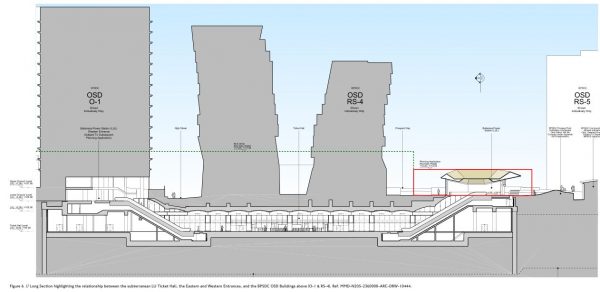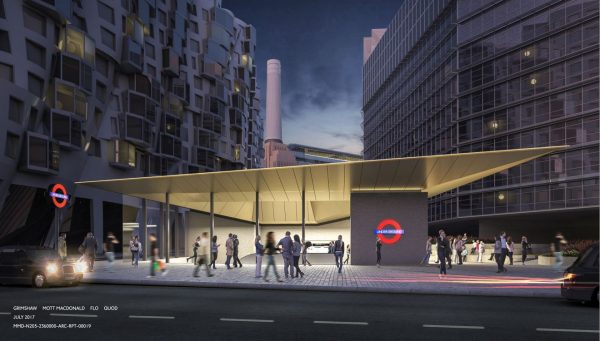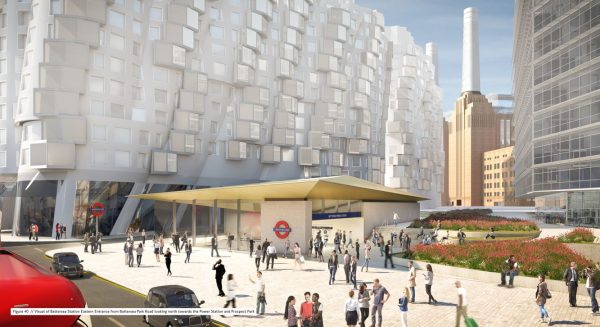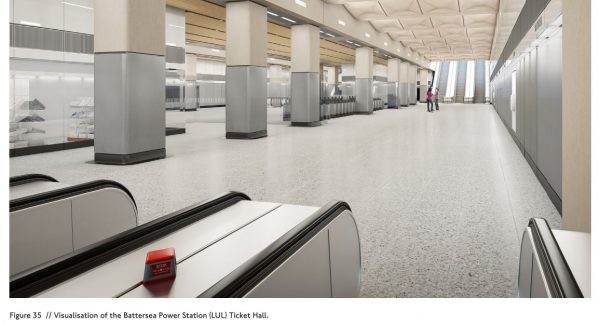Wandsworth Council is consulting local people on London Underground’s plans for the eastern entrance of the proposed new Battersea Power Station tube station.
The current planning application from TfL relates to the eastern entrance on Kirtling Street of the new Battersea Power Station tube station. Outline planning permission has already been granted, but the latest proposals are asking for approval for a more detailed plan.
The Eastern Entrance and Headhouse is conceived as a single, free-standing pavilion structure, made up of two connected volumes, the public entrance sits to the South adjacent to Battersea Park Road with the subsidiary Headhouse set within the landscape to the North.
The flattened design of the entrance is basically to preserve some of the view of the old power station that can be glimpsed through the gaps in all the new residential flats that are now surrounding it.
The heavy use of glass, which we’re seeing a lot more of in new tube station entrances isn’t just cosmetic — it’s a technique known as “passive wayfinding”, where people can start to see where they want to go as they rise up the escalators. The idea being that a percentage of people will be able to leave the station space quicker and not clog up the entrance looking around to see where things are.
The back of the public entrance is the head-house, which houses emergency exits and some electrical plant equipment.
The name of the station is already proving a bit of a headache though. London Underground have confirmed that the new station name will be ‘Battersea Power Station’.
Which means that documents talking about the area have to refer to the tube station to as ‘Battersea Power Station (LUL)’ to avoid confusion with the Grade II* listed Power Station.
That wasn’t thought through properly.
The new tube line is expected to be running by 2020.
To see the proposals and to comment online go to the planning section on the council’s website. In the search box on the right, type in the application numbers: 2017/4269 and 2017/4274. Then wade through lots of documents.
Wading through planning documents can be informative though – for example today I learned that the collapsible metal gates that are pulled across tube entrances when the station is closed are called Bostwick Gates, after the London firm that invented them.










It would be just the height of convenience if it went on to connect with Clapham Junction.
I Can only agree with you there. this way stress will be removed from the overground massively and, would be a great alternative to riding all the way into Waterloo/London Bridge to get on the tube.
It would also be more popular than it will be if left as-is IMHO.
If it did, then the trains would be full when leaving from Clapham Junction and of no use to the private companies at Battersea who are funding the extension. Whilst there is passive protection for an extension to Clapham, it was a conscious choice *not* to extend the line there at this stage.
Curious they haven’t included the western entrance.
That’s a different planning application.
Yes, it should definitely extend to Clapham Junction. Why not?
Surely it should be Battersea Power Station Station !
I believe the rationale for the extension not going to Clapham (yet) is that if it did so before Crossrail 2 was in place, the Northern Line would be overwhelmed, which would create far bigger problems than it solved.
The reason for the extension is not going to Clapham is simple: The developers are paying TfL big bucks to build a tube extension to their new development, and they want to advertise a guaranteed seat on the tube as one of the selling points.
Wandsworth Guardian letter to the Editor,
on a similar subject.
But looking at the whole design as top northern facing. No under the road linking the south part of Nine Elms.
Could be due to a large diameter sewer pipe or tunnell running along the whole length of Nine Elms Lane.
But if engineers could have got over that problem in some way. Commuters heading off to Embassy Gardens wouldn’t have to cross a very busy main road.
In general there is a move away from having subways under roads as people simply don’t like using them. Where possible, existing ones are being filled in 9City of London, Elephant & Castle etc) and replaced with street crossings.
Good summary here, thanks Ian. Is the planning permission for the western entrance to come later? Hope to see a similarly useful summary if you have time!